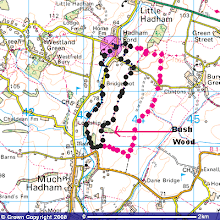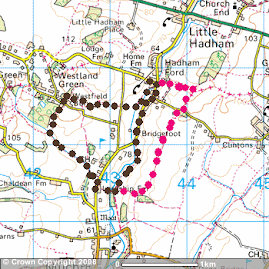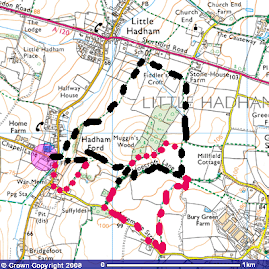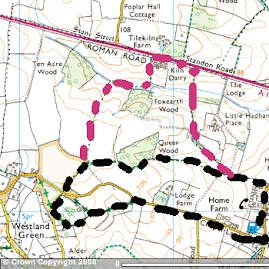After a long and extremely hot day, I switched on the garden Skinner 125W trap and set off for Hadham Hall with the battery powered Heath 15W trap. I planned to return to the same spot visited last month, between 2 ponds and surrounded by mature trees, some of them native.
 |
| Trap set to the right of this picture, on the edge of this well vegetated pond |
By 8.30 the lights were on and, as it was not quite dark enough, I sat down and opened a beer. By 8.45 it was dusky and so off wandering with a bag of pots and headtorch and net. Agriphila tristella were everywhere, with well over 100 netted. After checking the first 30 for Ag. selasella (very similar) I became too busy to check anymore. I recorded 30 as the number encountered.
Things were slowly coming to the sheet next to the trap and I was potting these, then listing. I divided them all into 2 groups, release ones and need to take home for photos/identification confirmation.
I spent some time wandering the older woods near the carpark: green carpets and Pleuropyta ruralis but not too much else.
By 10.30 I had nearly run out of pots with several good species potted for photos, including Oak hooktip, lime speck pug, Tree lichen beauty, Achroia grisella (lesser wax moth) and Galleria mellonella (wax moth.) Clearly a bees' nest nearby. However, the highlight was what looked like Depressaria radiella (parsnip moth) which is listed as uncommon for Herts. Latter confirmed at home to be this species.
The lights were turned off at 11.15 and I headed home to check those I had retained. An excellent night. In all 98 moths of 32 species and 1 new for parish records and 2 new for 2016.
 |
| A surprise netting at 10.00pm, a flushed Holly blue! |
 |
| Tree lichen beauty |
 |
| Female Cataclysta lemnata |
 |
| Achroia grisella |
 |
| Galleria mellonella |
 |
| Oak hooktip (NB This is a first gen insect, not the specific 2nd gen taken last night) |
Hadham Hall Numbers and species.
Micros:
5 Agriphila geniculea
30+ Agriphila tristella
3 Pleuropyta ruralis
1 Blastobasis adustella
1 Pyrausta aurata
1 Evergestis forficalis
3 Crambus perlella
1 Depressaria radiella (new for parish records)
1 Cataclysta lemnata
1 Achroia grisella (new for year)
2 Galleria mellonella
1 Acleris forsskaleana
1 Acrobasis advenella
Macros:
1 Yellowshell
6 Green carpet
3 Snout
7 Brimstone
3 Square spot rustic
3 Orange swift
1 Six striped rustic
1 Angle shades
4 Setaceous hebrew character
1 double striped pug
1 Lime specked pug
1 Straw dot
1 Oak hooktip (new for year)
5 Flame shoulder
1 Small square spot
1 Tree lichen Beauty
5 Lesser BB yellow underwing
1 Garden carpet
1 Red twin spot carpet
Once home, I began potting all the insects that were on the fence and the top of the garden trap. There were a fair few and everytime I retrurned from identifying them and recording them in the moth shed, there were more. At 1.15 I had one last session ans potted a very bright micro. Confirmed as Enarmonia formosana, another new moth for the records.
This morning, slightly later than usual, I emptied the trap and in total, recorded, (including last night's garden haul) 86 moths of 41 species. These included new for year records of Treble Bar, Udea ferrugalis and Marbled Beauty. However, undoubted highlight, a Vestal. This a migrant moth from Europe that usually migrates north as from mid August, but an uncommon visitor as far inland as Hertfordshire. A pleasing capture indeed.
 |
| Vestal |
 |
| Enarmonia formosana |
 |
Udea ferrugalis
|
 |
| Dusky Thorn |
Moth species and Numbers from the garden
Micros:
2 Carcina quercana
1 Ypsolopha sequella
8 Emmelina monodactyla
5 Agriphila geniculea
2 Pyrausta aurata
1 Hypsopygia costalis
1 Pandemis corylana
5 Agriphila tristella
1 Enarmonia formosana (new for parish records)
2 Cochylis hybridella
1 Argyresthia goedartella
1 Agapeta hamana
1 Pleurpoyta ruralis
1 Yponomeuta malinellus
2 Celypha lacunana
2 Monopsis weaverella
1 Catoptria falsella
1 Acrobasis suavella
1 Udea ferrugalis (new for year)
1 Blastobasis adustella
Macros:
1 Green carpet
8 Brimstone
2 Scorched carpet
1 Dusky thorn
1 Snout
4 Straw dot
1 Light emerald
9 Square spot rustic
3 Lesser BB yellow underwing
1 Common carpet
1 Marbled beauty (new for year)
1 Maple pug
3 Flame shoulder
1 Common wainscot
1 Yellowshell
2 Small square spot
2 Six striped rustic
1 Common rustic
1 Copper underwing
1 Treble bar (new for year)
1 Vestal (new for parish records)
All these additions take the total to in excess of 5700 moths identified this year of 428 species for 2016, made up of 205 micro species and 223 macro species.
The new additions to the parish list mean I have now recorded 635 species in total in Little Hadham, made up of 326 macro species and 309 micro species. With a bit of luck and hard graft, could get to 650 species for the village by the end of this year.

































































































